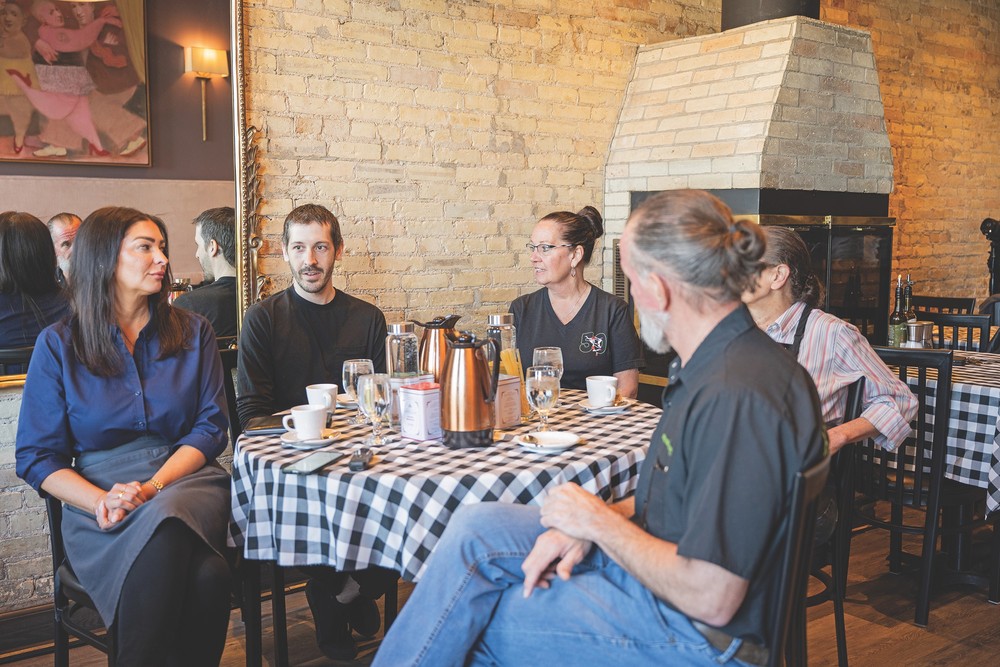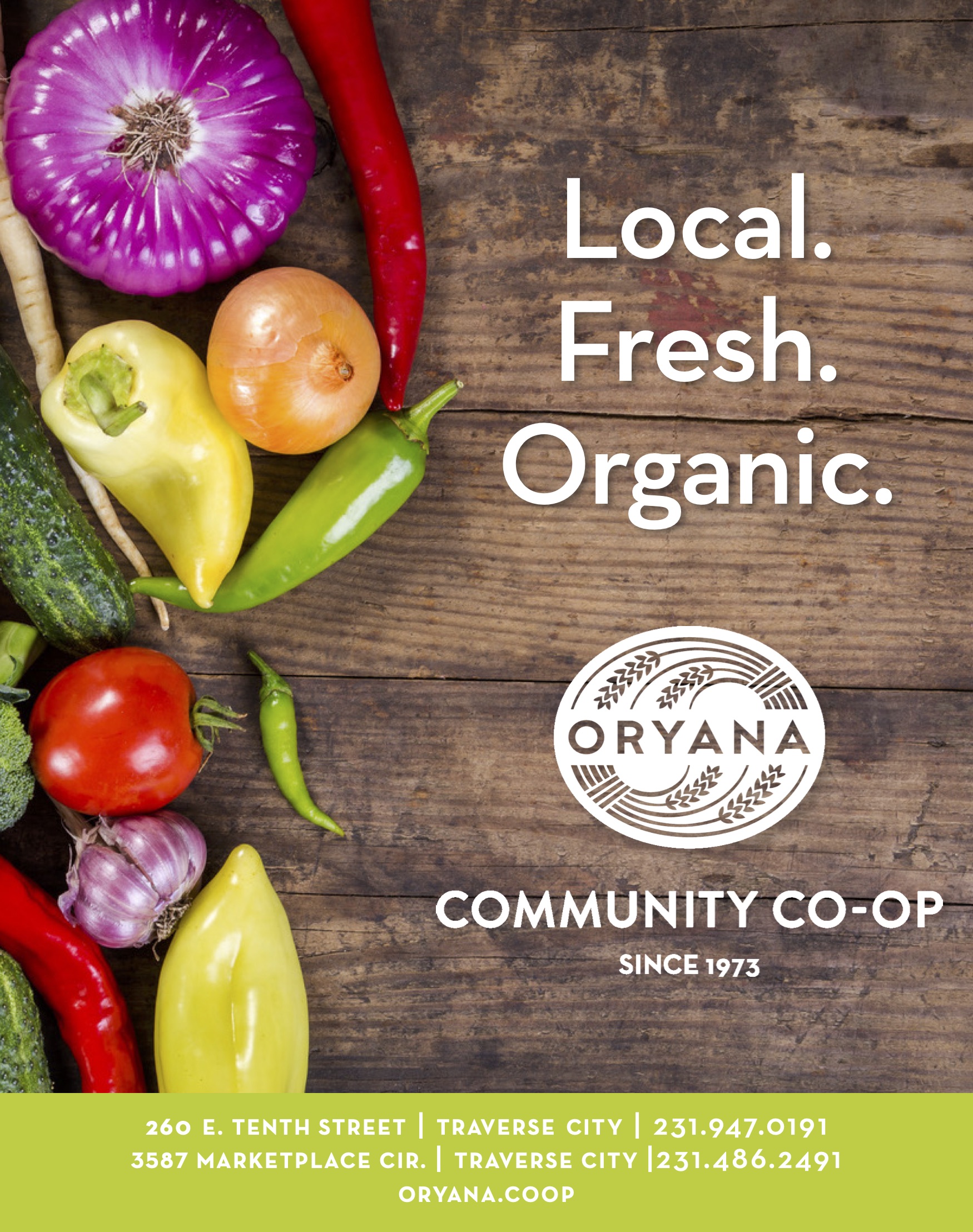Behind the Apron: Veteran servers discuss decades of work in northern Michigan
June 2025
Jess Ambrose, Trattoria Stella
Years of industry service: 15
Andrew Hoadley, Amical
Years of industry service: 19
Debra Kirt, Mode's Bum Steer
Years of industry service: 51
Laurie Thompson*, Brady's Bar
Years of industry service: 39
Dave Millar, Jolly Pumpkin
Years of industry service: 40
*Actual last name withheld at subject's request
Servers are the lifeblood of a restaurant.
After the quality of its food, there’s arguably nothing more important to a restaurant’s reputation than how its customers are taken care of. Part of eating out, after all, is the enjoyment of the overall experience.
And while serving can be handled by anyone, including entry-level kids or those with little experience, restaurant owners and managers will tell you that servers who can make a career out of this profession are a cut above. A step ahead. They’re just … better.
The TCBN assembled a roundtable of five local servers with more than 160 years of combined experience behind the apron to discuss their profession.
More than waiting tables
The first thing this group will tell you is that waiting on customers is merely the visible tip of the iceberg. Before Jess Ambrose walks up to a table at Stella, for instance, she needs to know about the ever-changing menu and be prepared to tell customers in detail about the local ingredients that Stella prides itself on.
“I’m not just there to write down your order. I need to have the food and wine knowledge for a menu that changes every night and a wine list that has over 400 bottles,” she said. “And there’s so many local farms and things like that in Traverse City, and you’ve got to be familiar with them, too. There's a lot of continuing education.”
That’s not to say there’s any less work at more casual establishments. Over at the iconic Mode's Bum Steer, the cross-trained servers are ready to take on anything, quite literally. This means there’s no real down time, even when tables are empty.

“We do dishes. We cook lunches. We bartend, we clean, we vacuum – we’re not just servers,” said Debbie Kirt, who has logged 40 years at Mode’s. “We do everything.”
But at least it’s simple enough to serve the food and collect payment, right? Wrong. This is especially true as our digital age forces new continuing education of its own.
“I had to learn how to do not one, but two different handheld [point of sale] systems,” said Laurie Thompson, a nearly 40-year veteran of Brady’s Bar. “And the very first day we got the first system, I got three hockey teams after a tournament that all wanted separate checks. You had to just throw your hands up.”
The job can be physically taxing – lots of ups and downs, lifting and constant movement, all on your feet – but the real stress is on the mind. Especially as restaurants face staffing issues, these servers have to juggle a lot as they cover large swaths of the floor.
“You’re always prioritizing the next six things you have to do. Suddenly number six is number one and number one can wait until after four, and your head just does all of that automatically,” Millar said. “You get home from work at three in the morning and you're laying there trying to go to sleep and your brain says, ‘God, that guy still needs a Budweiser.’”
You also have to navigate and balance a variety of people (and their assorted needs, quirks and emotions) as you go about your business.
“You have to manage a lot of personalities,” Ambrose said. “Front of the house, back of the house, support staff, bartenders, guests.”
Then there's the part where, as a veteran, you have to impart your wisdom upon the freshly hired youngsters. It can be a chore.
“The classic is the girl that comes in and you're training her, and she says ‘I’ve worked at Applebee's for three years, I know what to do.' And it’s like ‘You don’t.’ There are so many subtle nuances you pick up along the way … and every place is different," Millar said. "Waiting tables here is not waiting tables there."
The best part
These servers shared no shortage of perks when asked what they enjoy about their profession. It’s no surprise, then, that they and plenty of others have made a career out of it.
“I remember my first job, looking at my boss and thinking I’m not going to be doing this at his age," Millar said. "But then all of a sudden you wake up one day and you've been making good money, you get to travel, your schedule is flexible, and you can always get a job [anywhere you go] and you say, ‘I guess I’m going to keep doing this.’”
Many restaurants are now starting to offer health and other benefits that weren’t common in years past, adding another network of support and appeal to what was for years a “grind-it-out” profession.
The unanimous response when asked what they like best about the job, though, is the people. Many customers, especially the regular ones, have a way of filling servers’ cups with friendship, laughs, support and advice.
“I’ve learned more life lessons at Mode’s than I could ever learn anywhere else,” Kirt said.
Real, meaningful customer relationships are built in this work, particularly in the colder months when those who live nearby aren’t scared off by the hordes of tourists.
“I have a couple I’ve been waiting on every Saturday night for 15 years. You build friendships with them. We’ll meet for coffee. I’ve gone to dinner at their house. I’ve watched their kids grow up,” Ambrose said. “I respect summer for what it is, but I prefer the off-season when you get to see all the regulars and locals.”
Servers know that seeing a familiar face is important, especially when the customer in question needs far more than a simple meal.
“We’re therapists. We’re counselors. People come for comfort,” Kirt said. “When someone loses their spouse, sometimes it’s hard to come back in the restaurant, especially if you’re used to coming in with your husband [or wife]. As soon as they come in, I run up and give them a big hug.”
There's plenty more than hugs to give out. Serve long enough in one town and you also compile an impressive list of community resources for anyone who may need them.
As Millar put it, “I’ve always got a guy.”
“You know a plumber, you know somebody who can fix your car,” Thompson added. “You always know somebody who can help.”
It’s also an honor to feel valued and respected for what you do, these servers say, because at their level, they are in demand. This is particularly true at fine dining establishments like Stella, where the service is key to navigating what could otherwise be an overwhelming experience.
“I have so many regulars – people who will come in and always request me,” Ambrose said.
And it’s more than just the customers. Behind the scenes, there is a strong and close-knit community of servers and other restaurant folks who know and respect each other.
“The people you work with is a big part of it,” Millar said. “It’s amazing the lasting friendships you develop from working with somebody in the trenches.”
The worst part
 Millar, photo courtesy of Megan Renae Studios
Millar, photo courtesy of Megan Renae StudiosThe best part of the job, as it turns out, is also the worst. Difficult coworkers are no fun, but difficult customers are even tougher.
“The people that we love serving and getting to know and hearing their stories sometimes just aren't a pleasure to get to know or hear their stories,” Millar said. “If you go into work and you're already having a little bit of a bad day, it can be amplified really quick by [bad customer behavior].”
Every server has horror stories about bad customers. Millar says years of experience have given him the ability to push back in a firm but respectful manner.
“You can clap back. You’ve got to be careful, and it’s a fine line, but you can do it,” he said. “I had a lady when I was as busy as I could be who was literally banging her silverware on the table after I told her I'd be right with her. I said, ‘That's great for getting my attention, but it makes me not like you.’ Everybody else at the table smiled and we moved on from there.”
Just as important as what you say, though, is how you say it.
“I managed a girl one time and I had to tell her, ‘You can’t talk to a customer like that,’ and she told me, ‘I’ve heard you say the exact same words!'” Millar said. ‘And I said, ‘Yeah, but I didn’t have the bulging vein in my forehead when I said it.’ Delivery is important.”
Ambrose says she’s learned “tactful ways” to ensure that her customers are giving her the respect she deserves as a person and professional.
“There’s a difference between being a server and a servant,” she said.
With experience also comes understanding and the ability to overpower bad energy with good.
“I had a guy who was in one night by himself, and he was rude and ordering me around like I was nothing. When I brought his food and set it down, I smiled and said, ‘I hope this makes your day better,’” Thompson said. “And he looked at me and he said, ‘I was taking it out on you, wasn't I?' And I said, ‘We all have those days, don't worry about it.'"
Tip talk
These servers were unanimously and strongly opposed to a recent push to remove the longstanding tip credit that allows restaurants to pay tipped staff a fraction of the minimum wage.
While mandating that servers be paid the minimum wage wouldn’t technically prevent tipping, servers worry there would be less incentive to tip, and therefore much less money in their pockets (experienced professionals can make very good money in the tip system).
“People will hear [that the restaurant is paying us more] and think, ‘Oh, they’re all good. They don’t need tips,’” Millar said. “Last summer, even when they just started talking about it, we saw more 10% and 15% tips.”
Though they haven’t yet seen it directly impact their tips, these servers are at least mildly worried about “tip fatigue” from customers who are now getting hit with tip requests in places they hadn’t before. When the convenience store clerk turns around that tablet and asks for 10, 15 or 20%, things are getting a little weird.
“We’re talking about it being annoying, and we’re people who live on tips,” Millar said. “So that tells you something … it’s getting a little out of hand.”
There is no truth to the oft-repeated suggestion that tourists tip any worse or better than locals, servers say. By and large, a good or bad tipper is that way regardless of who they’re dealing with.
Tips (which are the overwhelming portion of these servers’ income) vary throughout the season, with some surprises compared to what non-servers might expect. June can be “fool’s gold,” for example, because locals get super busy with a variety of things (graduation parties, vacations and more) but the full tourist surge hasn’t yet arrived.
Servers, especially veterans like these, have learned to ride the waves.
“You get creative with your money. You really do,” Thompson said. “You learn how to manage it, balance things and save for the what-ifs.”
Trends, odds and ends
The post-COVID era has reshaped restaurants and their staff in more ways than one, and it’s changed the way the whole industry does business.
The open hours that were cut during COVID and its wake probably won’t return, but that’s not necessarily a bad thing, servers say. Some of their restaurants are making more money while providing their best food and service in shorter hours than in years past.
“COVID checked us on that whole 24/7, 365 way of thinking. You go to other countries, and the market closes at 6 o'clock. But here, we’re so used to wanting a Twinkie at 10 o'clock and being able to get it,” Millar said. “Let’s let the places close down. Every place doesn’t have to be open until 11.”
There’s also been a trend of more restaurants settling into a niche. Not everyone has to do breakfast, lunch and dinner. Pick one or two and do them well, then reap the benefits.
Many decisions on hours, of course, are directly related to available staffing. Finding reliable workers has been a massive challenge for all industries since COVID, and problems in hospitality have been particularly severe. While a number of factors are at play, the lack of available and affordable housing is likely to cause increasing problems for people in the service industry.
“The next generation [of servers] is really going to have an issue,” said Andrew Hoadley, who works at downtown staple Amical. “They’re already starting to struggle.”
This problem could eventually cripple the industry itself as restaurants have a harder and harder time finding staff.
“People want to know why they have to wait two hours for a table or why something wasn't perfect, and it’s because restaurants can't afford to pay people enough money to live here,” Ambrose said.
For now, though, plenty of new people still want to be a part of Traverse City’s celebrated restaurant scene.
“Our younger staff is really enthusiastic about working in restaurants here,” Hoadley said. “They like the scene, they like the food, they like the people, they like the industry.”
And that’s good, because Traverse City’s restaurant culture continues to grow, despite staffing challenges.
“Statewide, and especially in Grand Rapids, they have a lot of restaurant loss – at least seven or eight since January. And you don’t really see that as much up in Traverse City,” Hoadley said. “We seem to have a safe little bubble. If anything, we have people traveling here to open up restaurants.”
Photos by Megan Renae Studios














